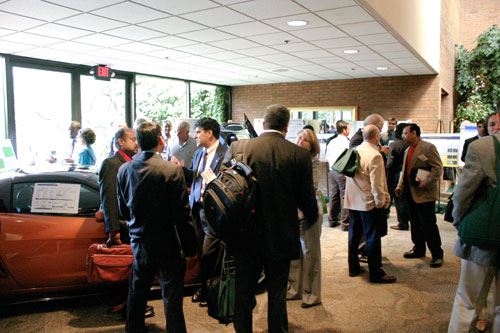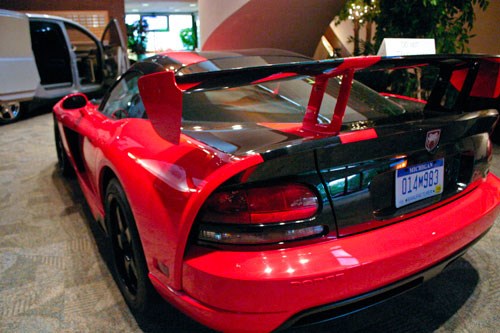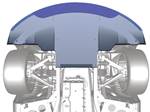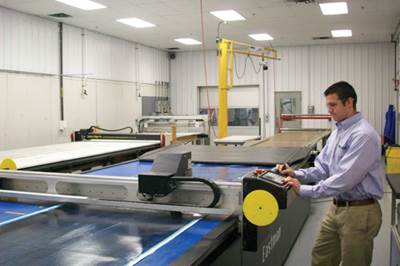SPE's ACCE 2010 preview
Charting a composites course through the auto industry’s “perfect storm.”
For the 10th time in as many years, the Society of Plastics Engineers (SPE) will hold its Automotive Composites Conference & Exhibition (ACCE) at the MSU Management Education Center in suburban Detroit, Mich., Sept. 15-16. After a record-breaking two-year global automotive downturn, the organizers — the Society’s Automotive and Composites Divisions — are upbeat about the event. The hope is that composites will finally get the attention and significant programs they deserve from automakers now desperate to shed mass, improve fuel economy and manage cost at much lower production volumes, yet still meet consumer demands for quality, connectivity and luxury in all vehicle segments.
The conference has a history of taking place during interesting times. It made its début just days after the post-9/11 travel ban was lifted over U.S. airspace, permitting speakers, attendees and exhibitors to fly or drive in for an event show organizers weren’t sure was going to happen. The 2008 show — then at its largest in terms of number of days (three), exhibit space, speakers and attendees — opened just as the U.S. economy went into its recent tailspin, taking a significant chunk of the world’s economies with it. A somber and smaller 2009 event still managed a respectable showing and a determined demeanor, despite catastrophic local job cuts, abundant bankruptcy filings among automakers and their suppliers, and global losses in the industry that has traditionally base-loaded production plants among the world’s resin suppliers. The question, of course, is What will the 2010 show be like?
Unsure if the economy would pick up or continue to be slow, conference planners played it safe and limited the show to two days again this year, rather than returning to the three-day format that was introduced in 2005. They have, however, assembled a strong technical program centered on the theme “Composites: Shaping New Vehicles.” In addition, sponsorships are slowly returning to previous levels, and the event’s usual abundance of high-profile keynote speakers are well in evidence.
Leading off an international slate of keynoters (six, so far) is Mike Jackson, director – North American Vehicle Forecasts for CSM Worldwide (Northville, Mich.), who will open the conference with “Trends in North American Vehicle Builds.” He will be followed by Luciano DeOto, division chief of the Advanced Composites Development Center at Automobili Lamborghini SpA (Sant’Agata Bolognese, Italy), and Paolo Feraboli, assistant professor – Aerospace Structures & Materials, Department of Aeronautics & Astronautics, University of Washington (Seattle, Wash.), who will copresent a talk on “Carbon Fiber Composites Research & Development at Automobili Lamborghini.” The iconic automaker has promised to bring one of its carbon composites-intensive vehicles to the show. Wednesday’s luncheon speaker, Antony Dodworth, R&D manager, Bentley Motors Ltd. (Crewe, U.K.), will discuss next-generation vehicle work in “Birth of the T35 Sports Car: Releasing the Familiar & Secure to Embrace the New.” On Thursday morning, Roger Assaker, owner and CEO of e-Xstream Engineering SA (Louvain-la-Neuve, Belgium), whose software is widely used in the auto industry, will discuss “Predictive Modeling of Reinforced Plastic Materials & Parts: State-of-the-Art and Future Challenges.” Thursday’s lunch speaker, McLaren Automotive Ltd.’s (Guildford, U.K.) function group manager – Body Structures, Claudio Santoni, will discuss project, “The CFRP MP4-12C Monocell.” The closing keynote will be given by Rani Richardson, CATIA composites product specialist at Dassault Systèmes (Vélizy-Villacoublay Cedex, France). She will discuss technology transfer in “Flying Off the Line: How Aerospace Knowledge Can Accelerate the Use of Composites in Mass Produced Autos.”
The conference’s technical program offers an equally diverse look at composite materials and processes (for details, dates and times, see SPE's full preliminary ACCE program, as of July 10, in the last two images at right). Traditional sessions include Advances in Thermoplastic Composites (with updates on long-fiber thermoplastics — LFT and direct-LFT — as well as nylon in oil pans and engine mounts); Advances in Thermoset Composites (with updates on sheet-molding compound, polyurethanes and epoxies); Bio- & Natural Fiber Composites (featuring a variety of natural fiber reinforcements in thermoset and thermoplastic matrices); Nanocomposites (including graphite nanoplatelets and a new mesoporous silicate particle); and Virtual Prototyping & Testing of Composites (with papers on predicting fiber orientation, strength and creep, as well as scaling-down methodology and constitutive-property estimation). Of special note this year is the Enabling Technologies session, spotlighting a number of presentations on processing breakthroughs: A low-cost/low-pressure variant of compression molding; a new palletized-LFT process that reportedly achieves the design complexity of which injection molding is capable but with the fiber lengths of compression molded direct-LFT or GMT (glass mat thermoplastic); production of thermoplastic prepregs for use in thermosetting vacuum bag, VARTM and infusion processes; progressive forming of thermoplastic composites; high-volume carbon fiber-reinforced polymer (CFRP) stamping processes; and an advanced composite molding process with a 10-minute cycle time.
Two new sessions have been added. The first is a series of six papers on a collaborative effort by members of the United States Council for Automotive Research LLC (USCAR, Southfield, Mich.) under the session head Design & Development of a Structural Composite Underbody. The second session, called Composites: Business Trends & Technologies, features broadly focused topics: “Technology Development for Automotive Composite Part Production – New Materials & Processes” (Frank Henning, deputy director, Fraunhofer Institute for Chemical Technology (ICT), Pfinztal, Germany); “Tap Into Government: How to Leverage Government Money to Drive Innovation for Materials Development” (Susan Ward, CEO, ITECS-Innovative Consulting, New Smyrna Beach, Fla.); and “Plastics/Composites for Automotive Applications — Defending the Product Performance in Insurance Claims and Litigation Situations” (Jackie Rehkopf, senior engineer, Exponent Inc., Menlo Park, Calif.).
The auto industry’s trend toward eco-awareness will be much in evidence. Papers distributed across multiple sessions will cover a variety of green topics, including a new zero-VOC thermoset, thermoplastic additives that reduce VOC emissions at the source, and a method for recycling automotive headliners that are otherwise headed for the landfill.
The show’s annual and ever-lively panel discussion is also planned for the end of the first day, although the specific topic had not been announced at press time. The panel, which provides the opportunity for audience participation, will be followed by a networking reception sponsored by the SPE Thermoset Division.
“Our industry is in the middle of a tremendous shift toward a new generation of vehicles,” says 2010 SPE ACCE conference chair Cedric Ball, who recently took over as global marketing director at Bulk Molding Compounds Inc. (West Chicago, Ill.). Ball sees this year’s ACCE as a showcase for the shift: “We’re clearly seeing greater interest in — and the business case being made for — using composite materials. With tremendous pressures to improve fuel economy and lower production costs, we’re really in the midst of a ‘perfect storm’ of market pressures and industry trends that make composites more attractive for automakers than ever before.”
Related Content
Jeep all-composite roof receivers achieve steel performance at low mass
Ultrashort carbon fiber/PPA replaces steel on rooftop brackets to hold Jeep soft tops, hardtops.
Read MorePlant tour: Joby Aviation, Marina, Calif., U.S.
As the advanced air mobility market begins to take shape, market leader Joby Aviation works to industrialize composites manufacturing for its first-generation, composites-intensive, all-electric air taxi.
Read MoreMaterials & Processes: Resin matrices for composites
The matrix binds the fiber reinforcement, gives the composite component its shape and determines its surface quality. A composite matrix may be a polymer, ceramic, metal or carbon. Here’s a guide to selection.
Read MoreTroubleshooting thermal design of composite battery enclosures
Materials, electrical insulation and certification are all important factors to consider when optimizing electric battery performance against potential thermal runaway.
Read MoreRead Next
Composite wing key to high-speed stability
First mass-produced CFRP wing helps supercar achieve downforce and lateral acceleration values superior to many GT racing cars.
Read MoreCorvette's carbon hood creates shock and awe
North America’s first mass-produced, all-CFRP hood raises the bar for production sports cars.
Read MoreCW’s 2024 Top Shops survey offers new approach to benchmarking
Respondents that complete the survey by April 30, 2024, have the chance to be recognized as an honoree.
Read More



























